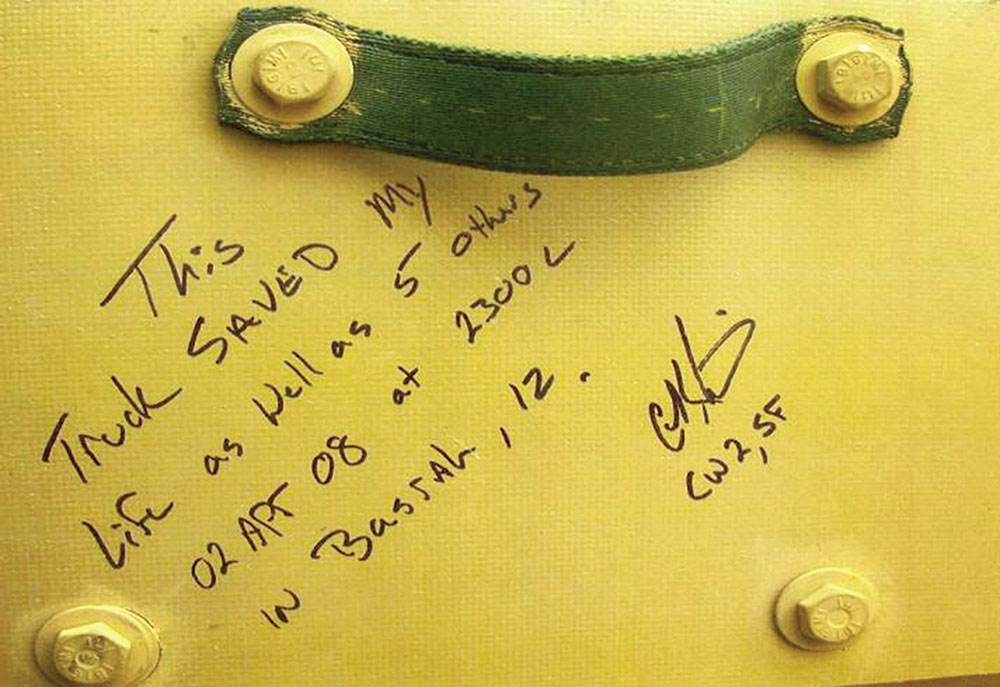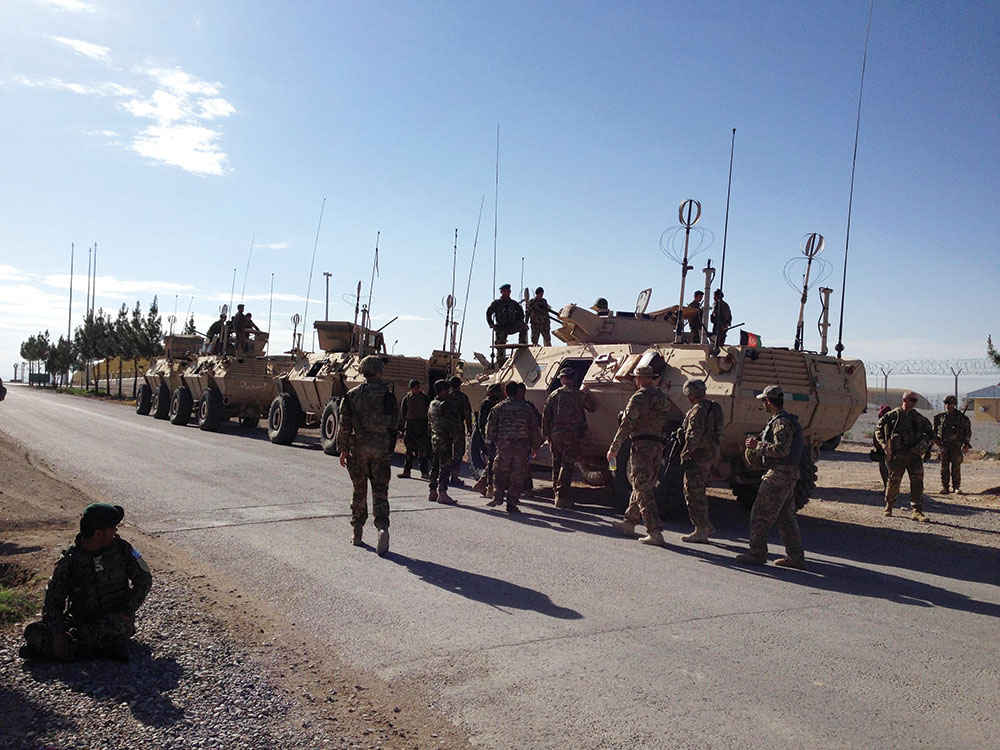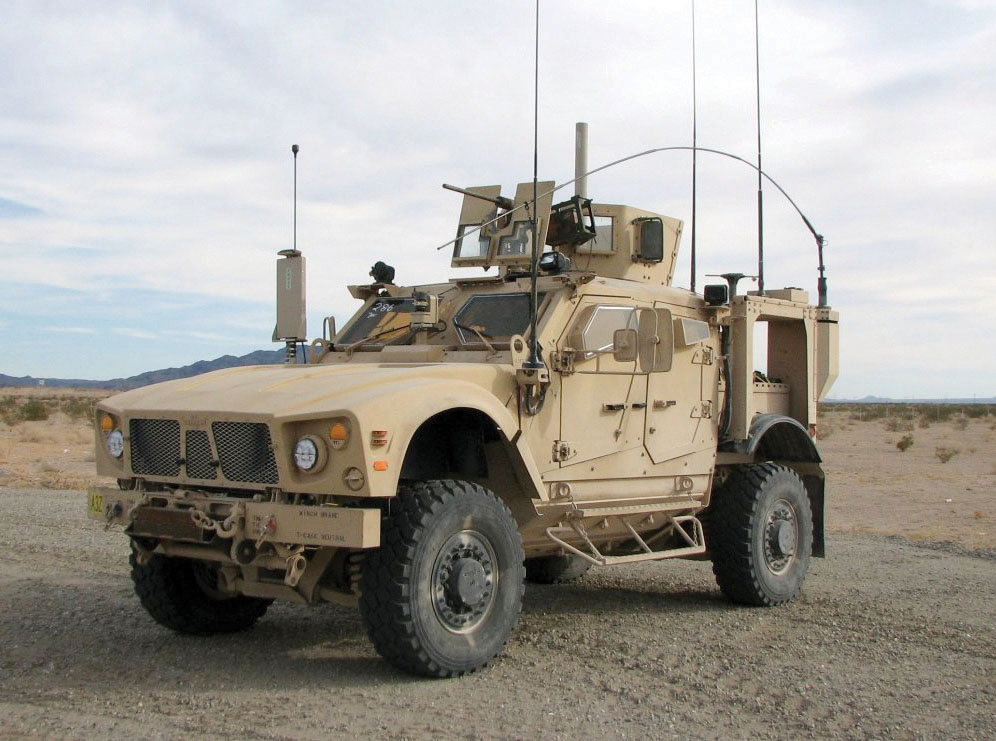
During the last decade of conflict, MRAPs rolled out of forward operating bases in Diyala and Ghazni and patrolled the streets of Kabul and Baghdad. MRAPs saved lives, protecting coalition troops from IEDs and rocket fire. DOD spent billions on them. Now, the MRAP fleet represents a valuable investment the acquisition community must maintain for the next contingency. To modernize MRAPs in today’s fiscally constrained environment will require innovation. Here, TRADOC’s Maneuver Center of Excellence proposes a strategy.
By Mr. Robert “Bob” Thomas, Mr. Thomas Stafford and Mr. Harry Jackson
The Mine-Resistant, Ambush-Protected (MRAP) capability is not an anomaly limited to the past decade of unconventional war, but probably will be needed anytime our Army is called upon around the globe. The Army’s enduring MRAP fleet consists of 8,585 vehicles in three variants: the MaxxPro Dash, MaxxPro Ambulance and MRAP All-Terrain Vehicle (M-ATV). These are the newest and most capable vehicles in the inventory, with the oldest produced no more than four years ago.
The Army is placing the majority of retained MRAPs in mission-dependent augmentation sets for use in future contingencies. Other retained MRAPs will be distributed across the force to facilitate unit training and extend the tactical network down to company level within division headquarters and the infantry and Stryker brigade combat teams (BCTs), through the addition of the networked capability set and key leader vehicle upgrades.

ENABLING POWER PROJECTION
During recent MRAP-enabled combat operations in Zabul province, Afghan logisticians of the 205th Corps successfully supported units without assistance from coalition forces—underscoring the increasing ability of Afghan forces to project power into historically insurgent strongholds. The MRAP capability is likely to be needed in future contingencies as well. (U.S. Army photo)
Given that the Army is likely to retain this capability into the mid- to late-2020s, how should the Army ensure that it stays ahead of anticipated threats? The U.S. Army Training and Doctrine Command (TRADOC) Maneuver Center of Excellence (MCoE) has proposed an MRAP modernization strategy that provides a template for planning, considering proven technologies to ensure that retained MRAPs evolve with the threat and operational environment. The strategy advocates incremental and affordable investments in capability so MRAPs can support unified land operations today and operate as needed around the globe well into the next decade. Although not yet formally approved or resourced by DA Headquarters, the strategy provides a starting point for discussing how to ensure that the enduring MRAP fleet remains highly capable in the future.
INNOVATION STRATEGY
The enduring MRAP fleet represents a significant investment of U.S. taxpayer dollars. For the acquisition professional, modernizing the fleet is a unique opportunity to provide careful stewardship of the MRAPs that have saved U.S. and coalition partners’ lives over eight years of combat in Iraq and Afghanistan. Innovation is key to implementing the modernization strategy in a resource-constrained environment.
Innovative capability enhancements will improve MRAPs along several lines of effort. The strategy also supports Army modernization objectives, generally adhering to the technology first principles from TRADOC Pamphlet (PAM) 525-3-1, “The Army Operating Concept [AOC]: Win in a Complex World,” published in October 2014. The “firsts” are shown in Figure 1.

FIGURE 1: MAPPING MODERNIZATION
The elements of MCoE’s modernization strategy for the MRAP are mapped to the first principles for technology outlined in TRADOC’s AOC. (SOURCE: Harry Jackson, MCoE)
The MRAP innovations are the result of lessons learned and Soldier feedback gained over more than eight years of MRAP use in combat. This can serve as a model for modernizing vehicles in the future.
LINES OF EFFORT
The proposed strategy focuses on the modernization of current or integration of new components, weapon systems and subsystems, using proven technologies to increase capability, reduce operating costs and provide longevity and durability. This strategy leverages nondevelopmental improvements and will use new-start developments as a last resort to add a critical warfighting capability or mitigate a critical system capability gap. In concert with vehicle modernization, the expanded efforts in training and doctrine are necessary to enable maneuver elements within the BCT and other brigades to employ the MRAP with emphasis on the Soldier and the squad, which are the foundation of the Army.
Training aids, devices, simulators and simulations will require improvements of similar fidelity to ensure training is relevant. Full use of the MRAP home station training fleet to support driver, crew and collective training will provide a seamless transition into the brigade operational project sets in the Army’s prepositioned stocks.
The MRAP modernization will focus on protection and survivability, operational suitability and effectiveness, lethality and sustainability. (See Figure 2.)

FIGURE 2: PROPOSED SOLUTIONS
Each line of effort in the proposed MRAP modernization strategy has its own approach, expected products and anticipated dividends. (SOURCE: Harry Jackson, MCoE)
PROTECTION AND SURVIVABILITY
Force Protection (AOC tech first principle 8 – anticipate enemy countermeasures). Properly secure combat equipment and supplies and integrate vehicle components to prevent them from becoming secondary injury mechanisms upon impact from hostile fire, explosive blast or vehicle incident. Provide rapid vehicle egress to facilitate crew emergency evacuation caused by fire or other immediate hazard inside the vehicle. Upgrade the Objective Gunner Protection Kit (OGPK) to the initiatives pioneered by the U.S. Army Armament Research, Development, and Engineering Center in the OGPK 2.0 configuration to mitigate turret separation during attack or accident, and explore means to protect the gunner from blast. Replace the current Gunner Restraint System (GRS) with the next-generation GRS as legacy systems wear out.
Survivability (AOC tech first principle 4 – design redundant systems that improve effectiveness under conditions of uncertainty). Sustain the effort to reduce effects of underbody overmatch and increase probability of defeating rocket-propelled grenades and other direct fire projectiles and munitions by leveraging new, lighter-weight solutions that increase the level of protection per square foot without degrading vehicle performance. Increase survivability of key automotive functions and drivetrain components to mitigate cheap mobility kills from small arms fire and fragmentation.

PUNCHING ABOVE ITS WEIGHT
Planned updates to the MRAP include looking at space usage to ensure that all necessary crew protection hardware fits on the vehicle, without exceeding weight limits that keep the MRAP mobile and agile—preventing cheap mobility kills from small arms fire and fragmentation. (U.S. Army photo)
OPERATIONAL SUITABILITY AND EFFECTIVENESS
Capability Set (CS) Support (AOC tech first principle 1 – emphasize integration of technology with Soldiers and teams). MRAPs move, power and protect the Army’s CS that provides mission command with on-the-move reach and reach-back networking communications and connectivity into the Warfighter Information Network – Tactical infrastructure. The enduring MRAP fleet will require integration of the networking communication systems down to company-sized units to enable reach-down to the Soldier equipped with Nett Warrior. MRAP variants must be programmed and planned for non-recurring engineering requirements over time, aligned with the network, mission command and tactical data radio modernization strategy.
Fleet Commonality (AOC tech first principle 7 – reduce logistical demands). Bring each variant to a common level of mobility and protection to streamline sustainment and operational employment and ensure complementary capability on the battlefield.

STEWARDS OF A LIFESAVING LEGACY
MRAPs have saved the lives of thousands of U.S. Soldiers and coalition partners. The MRAP fleet is an invaluable legacy—and as it is brought home for modernization, acquisition professionals become stewards of that legacy. (U.S. Army photo)
Safety Enhancements (AOC tech first principle 1 – emphasize integration of technology with Soldiers and teams). Mitigate risk of rollover through electronic stability control and other automotive safety enhancements. Improve Soldier human-factor integration to reduce common injury mechanisms that contribute to injuries to passengers and crew.
Increased Operational Payload (AOC tech first principle 8 – anticipate enemy countermeasures). Force protection improvements have degraded the vehicle’s ability to operate within the performance envelope because of axle weight limits. This will provide the ability to carry add-on armor and mission packages without losing automotive performance, while ensuring a margin for future growth.
Integrated Bridge (AOC tech first principle 2 – simplify systems and integrate Soldier training into design; and principle 9 – ensure interoperability). Provide single point of access to control vehicle and mission command equipment at common workstations to improve crew performance and ease of operation and reduce space claim. The integrated bridge facilitates seamless interface of the CS and can be leveraged for on-board power management.

BETTER GUNNER PROTECTION
The Army has invested significantly in MRAPs, adding protective features to keep Soldiers safer, such as the Objective Gunner Protection Kit on this M-ATV. Among other safety improvements, the Army will explore ways to prevent turret separation and protect the gunner from attack. (U.S. Army photo)
LETHALITY
Tube-launched, Optically-tracked, Wire command link-guided (TOW) Improved Target Acquisition System (ITAS) (AOC tech first principle 10 – consider scale and organizational implications). Field the TOW ITAS Integration Kit on the M-ATV to allow the infantry BCT (IBCT) to safely employ the weapon system when operating as an MRAP reinforced brigade. Integrating the TOW ITAS system onto M-ATVs provides mobile protected firepower for weapons companies and scouts. The TOW ITAS provides responsive, dedicated long-range precision direct fire, observation and targeting capabilities organic to the formation.
SUSTAINABILITY
Ownership and Operating Costs (AOC tech first principle 3 – maximize reliability and reduce life-cycle costs; and principle 7 – reduce logistical demands). Reduce operating costs through a reliability, availability and maintainability growth program, and lower consumption of fuel and other forms of operational energy. A formal reliability growth plan with documented strategy will enable continuous tracking of each enduring MRAP system’s reliability throughout the modernization process, with the intent of exceeding threshold capabilities to the extent that resources and priorities permit. Improvements in maintainability are expected to be realized through the reduction of failures; engineering or design changes to reduce repair time where deemed practical; and maturity of maintenance procedures as technical manuals transition from commercial off-the-shelf status to military standard. System availability, as a function of both reliability and maintainability, will likewise increase with improvements in those areas.

TOP OF THE LINE
The Army’s enduring MRAP fleet boasts 8,585 vehicles in three models: the MaxxPro Dash, MaxxPro Ambulance—pictured here—and M-ATV. Only the newest and most capable are being modernized for the long haul; the oldest vehicle in the enduring fleet is just four years old. (U.S. Army photo)
Training (AOC tech first principle #2 – simplify systems and integrate Soldier training into design). Implement advanced driver training, crew training and qualification, and expanded collective training within operational force through integration of mounted operations into IBCT doctrine, training and leader development.
CONCLUSION
The MRAP program is a great success story, having saved a significant number of U.S. and coalition partners’ lives in more than eight years of combat in Iraq and Afghanistan by fielding approximately 21,000 MRAPs to Army units alone and approximately 27,000 to joint and coalition forces. The Army is taking advantage of our nation’s investment in MRAP capability and is retaining 8,585 of the newest, most capable MRAP variants. Modernizing this critical capability requires innovation and thoughtful stewardship.
The TRADOC MCoE-proposed MRAP modernization strategy complements overarching Army modernization efforts by directly supporting Soldier and squad operations in highly survivable vehicles with improvements to mobility, safety, sustainment and lethality. The Army is expected to operate effectively and efficiently in the current and projected fiscally constrained environment. In these circumstances, the Army cannot and will not invest in new MRAP vehicles anytime in the foreseeable future. The modernization strategy leverages innovation and preserves the protected mobility capability of our force by efficiently making improvements to the vehicles the Army already owns. This translates directly into combat-effectiveness as our units deploy as part of a regionally aligned force or the Global Response Force in support of the national defense strategy.
For more information, contact Thomas Stafford at thomas.j.stafford.civ@mail.mil, DSN 835-4701 or 706-545-4701; or Harry Jackson at harry.h.jackson2.ctr@mail.mil, DSN 835-9930 or 706-545-9930.
MR. ROBERT “BOB” THOMAS is the Headquarters, DA systems coordinator for MRAP in the Combat Systems Sustainment Directorate, Office of the Assistant Secretary of the Army for Acquisition, Logistics and Technology. He holds an MBA from the University of Colorado and a B.S. in psychology from James Madison University. He is Level III certified in program management and Level II certified in test and evaluation management and is a member of the Army Acquisition Corps.
MR. THOMAS STAFFORD is the Support Systems Branch chief and lead MRAP combat development specialist in the Capabilities Development and Integration Directorate (CDID), MCoE, Fort Benning, Georgia. He received an M.S. from the Florida Institute of Technology and a B.S. from North Georgia College. During his career as an infantry officer, he served in various command and staff positions with the 2nd Armored Division, 197th Infantry Brigade and the U.S. Army Materiel Command.
MR. HARRY JACKSON is a project officer support contractor for the MRAP program in the CDID at the MCoE. He received his B.A. from Michigan State University and has completed the Army Logistics Management College Combat Developer Course. Before joining the MRAP team, he supported the Close Combat Munitions, Soldier as a System and Future Combat Systems programs in CDID. His military experience includes tours in infantry and special forces units and tactics instruction at the Infantry School. He is currently a futures integrator support contractor in the TRADOC Capability Manager – Armored Brigade Combat Team in the CDID.
This article was originally published in the October – December 2015 issue of Army AL&T magazine.
Subscribe to Army AL&T News, the premier online news source for the Acquisition, Logistics, and Technology (AL&T) Workforce. ![]() Subscribe
Subscribe







